History does repeat itself.
The Santa Ana winds and the accompanying raging wildfires have been a part of the ecosystem of the Los Angeles Basin for over 5,000 years, dating back to the earliest habitation of the region by the Native American peoples. Newspaper archives have many photographs of regional damage dating back to the beginnings of news reporting in Los Angeles. When the Los Angeles basin was primarily an agricultural region, the winds were feared, particularly by farmers, for their potential to destroy crops.
The Santa Ana winds are katabatic winds, which means that the winds blow downhill. In short, high pressure over the Great Basin (Nevada, Western Utah) and low pressure over the coastal sections of the California Pacific Ocean cause a pressure gradient. High pressure is sinking air, and this sinking air over the Great Basin flows outward in a clockwise spiral from the high-pressure center to the low pressure, which is rising air. This dry air sweeps across the deserts of the Great Basin toward the coast, where the pressure is squeezed due to different terrain features. Since air wants to take the path of least resistance, it gets sped up by channeling through the mountain passes to the lower coastal elevations as the low-pressure area off the coast pulls the air mass offshore. This results in some powerful wind, and if you’re a camper, you know if the fire is about to die and you blow on the flames, the fire often gets more intense as the wind fuels the fire beyond controllable levels.
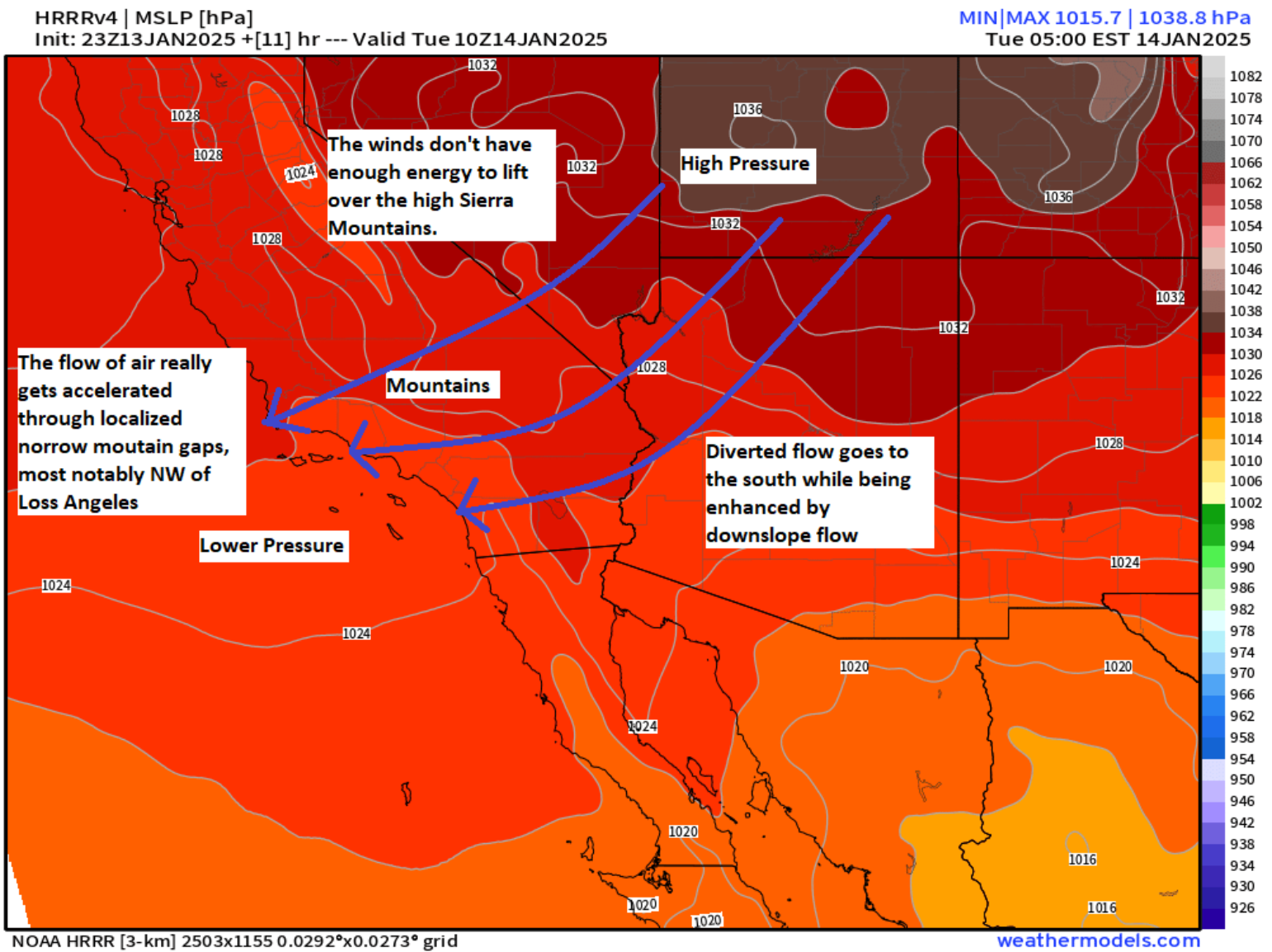
In general, these extreme fire weather regimes are predictable by at least seven days in advance, and we've seen this many times before, as it is a relatively frequent weather pattern across Southern California. This recent Santa Ana wind event might have seemed unusual because it occurred in January, not the typical months of October and November. But Santa Ana wind events can happen any time of the year, depending on the aforementioned overall weather pattern that causes them. Some recent research shows that there have been 71 years of Santa Ana wind events since 1948. They found the same amount of overall Santa Ana wind activity with no trend in activity. Still, the timing has shifted from fewer events in September and more in December and January.
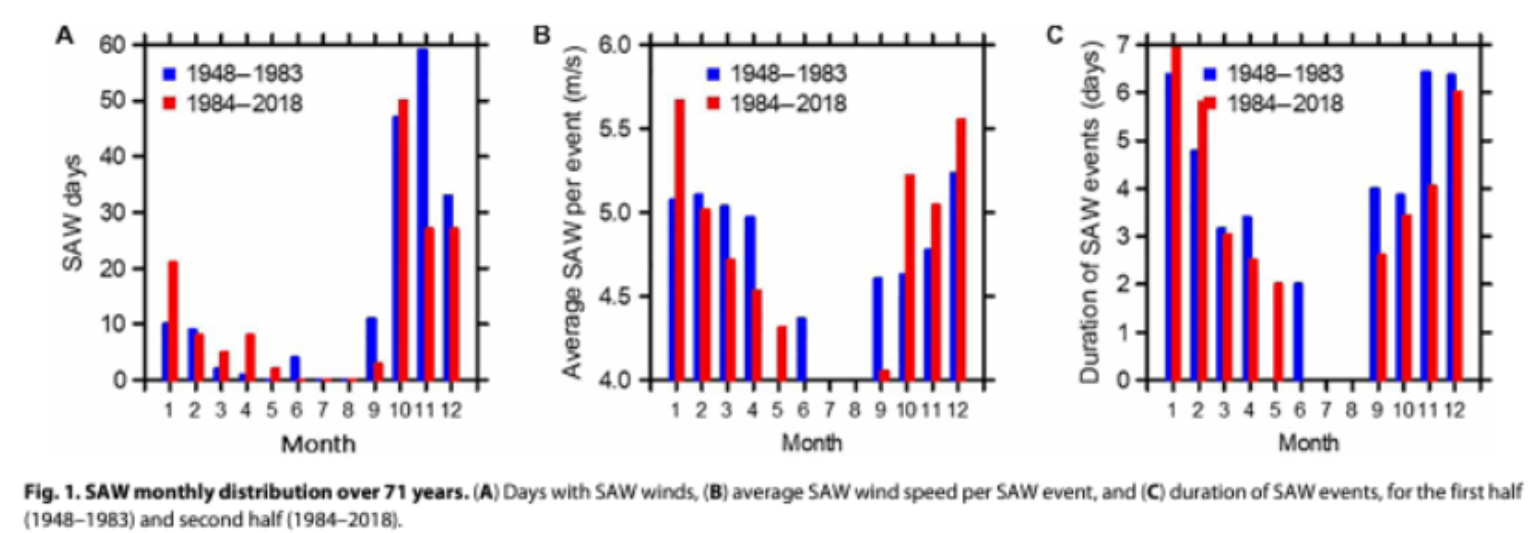
Lastly, we know fires are more common after wet-into-dry periods. It is not unusual for the Los Angeles area to dry in December and January. Since 1944, in the 30 days before January 9th, 13 years have received none to a tenth of an inch of rain, including 2024-25. Looking at droughts and rainfall, you will see that the area is drying, with drought conditions starting to resurface after a period of relative wetness that ended in early 2024. The trailing precipitation departures in the chart below show that the period from January 2023 to the middle of 2024 was pretty wet. Over the last couple of years, this wet period has increased fine fuel growth, which can easily catch fire and spread wildfire during dry times. The chart below also shows the region's wet and dry periods; the current period was turning dry but nothing as dry as past periods, so this current period is nothing unusual for the region.
We know dry periods with wind create fire, and humans start almost all of the fires associated with Santa Ana winds. Thus, history repeats itself once again with a very costly event for the insurance industry, not to mention the death toll and societal issues which arise from major catastrophes such as these.
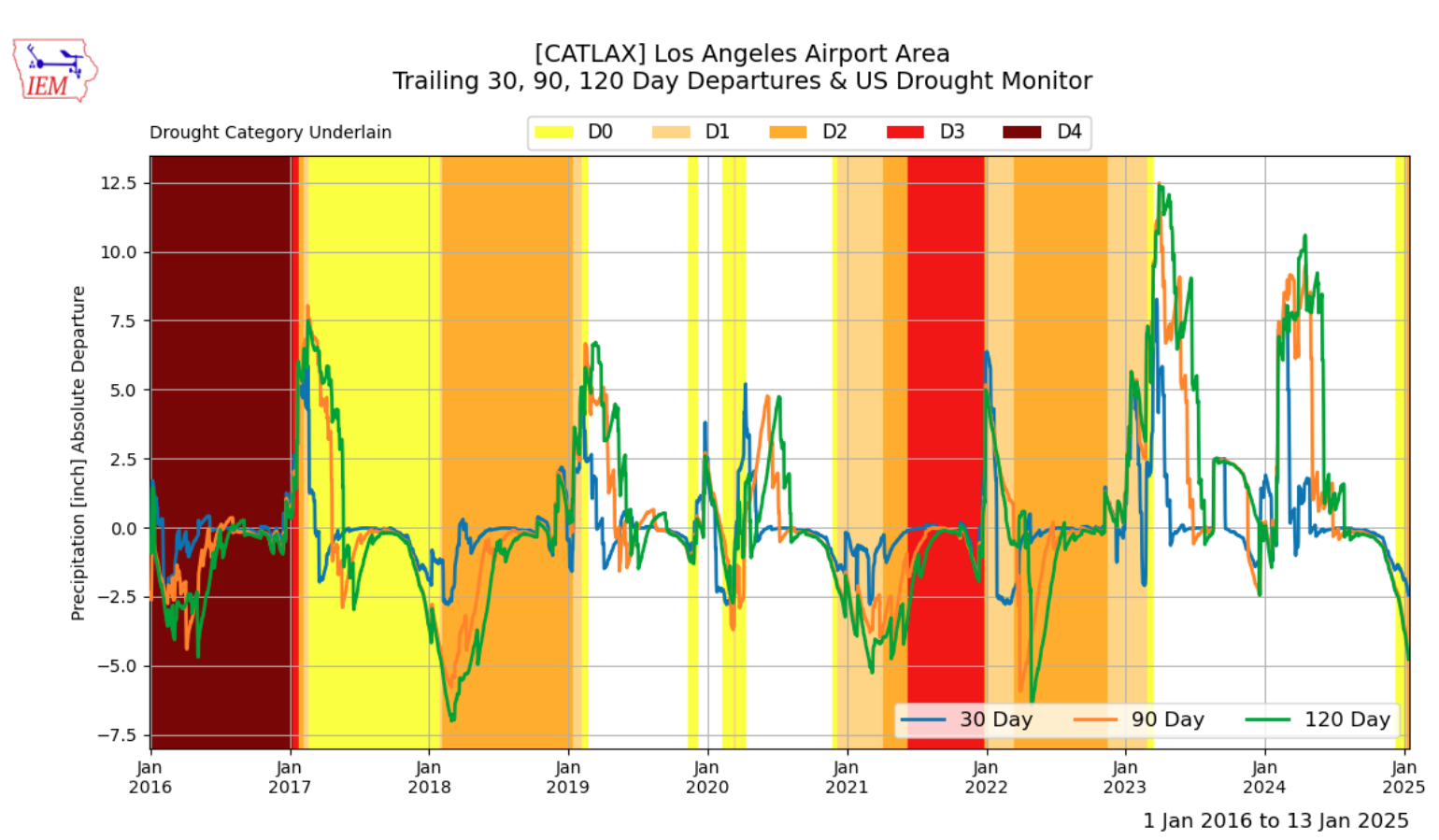
Wildfire Hazard Potential
In understanding the historical precedence of this fire, it is interesting that early European settlers observed the local Native Americans annually setting small fires in the hills of Pacific Palisades and Malibu to clear out the brush that would explode in a fire if left in place.
The week of November 6, 1961, saw the City of Los Angeles experience the most disastrous brush fire in Southern California's history, the Bel Air-Brentwood wildfire. Among the leading causes contributing to the difficulty of control were the copious amounts of dry, heavy brush and the prevalence of combustible shingle and shake roofs in the area. Subject to the Santa Ana winds, these factors supplied the means to make an urban fire conflagration possible, leading to the destruction of 484 dwellings and 21 other buildings. This also led to new ordinances which prohibited combustible roofs on all new construction and on all repairs, alterations, or replacements of roofs on existing buildings within the City of Los Angeles, specifically in the Mountain Fire District area. However, we now know that the city limits continued to expand beyond Bel Air and Brentwood, with the lure of sea breezes that mitigated the summer heat and views that stretched to downtown L.A. on one side and distant islands on the other, making it a desirable place for the wealthy build mansions on those hills as they extended far deeper into the Palisades hills than any developments had previously called the Wildland Urban Interface (WUI).
In fact, maybe our memory of wildfire natural disasters is all too short. Most recently, between November 8th and 21st, 2018, the Woolsey Fire destroyed 1,643 structures and damaged 364 just west of the current Palisades fire, resulting in $4.9B in damage. This shows that wildfires are common in this area. Past recent fires can slow the progress of new fires. The Palisades fire stopped at the edge of the most recent Franklin fire that started on December 9th, destroying 20 structures surrounding Pepperdine University.
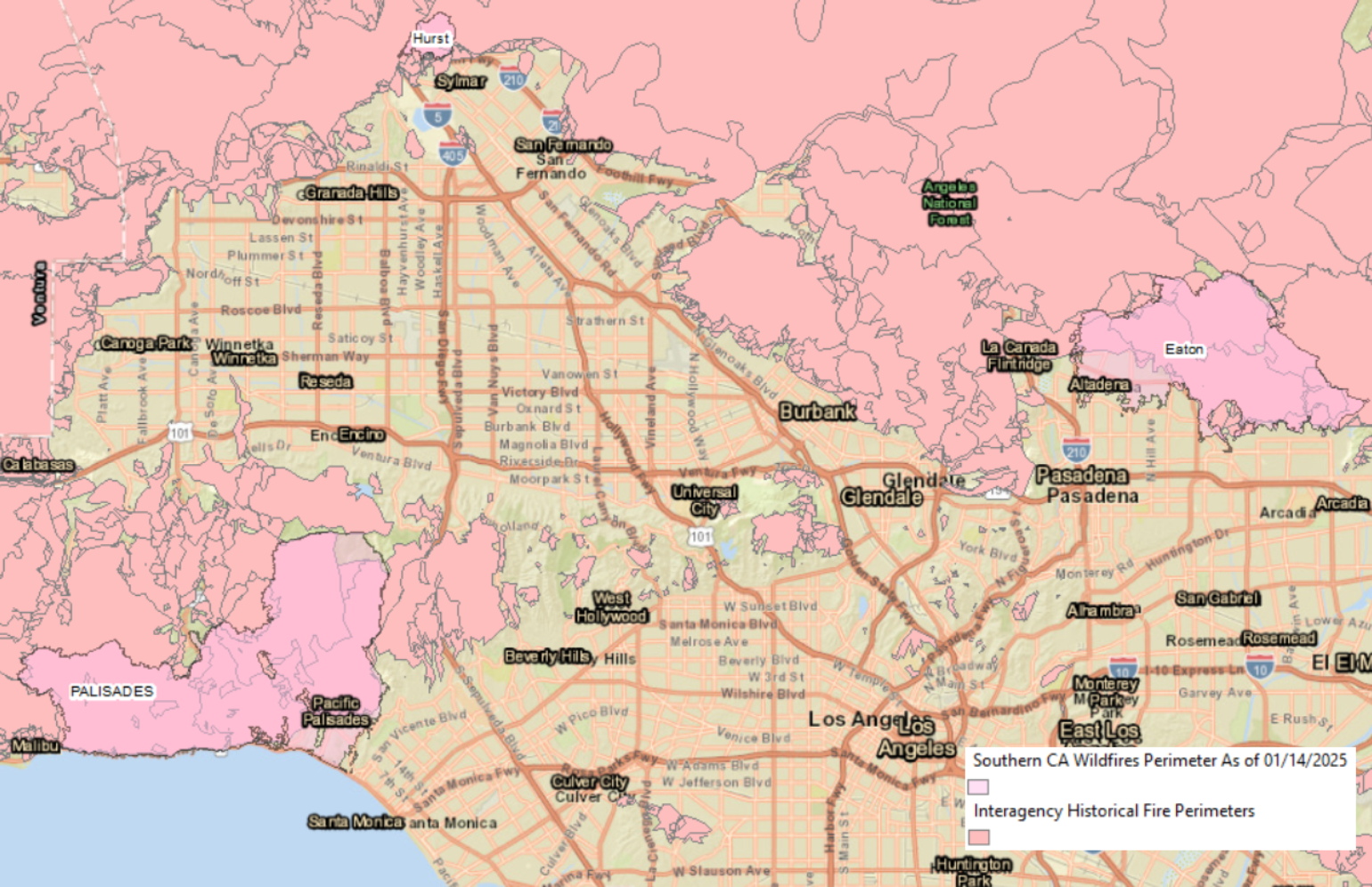
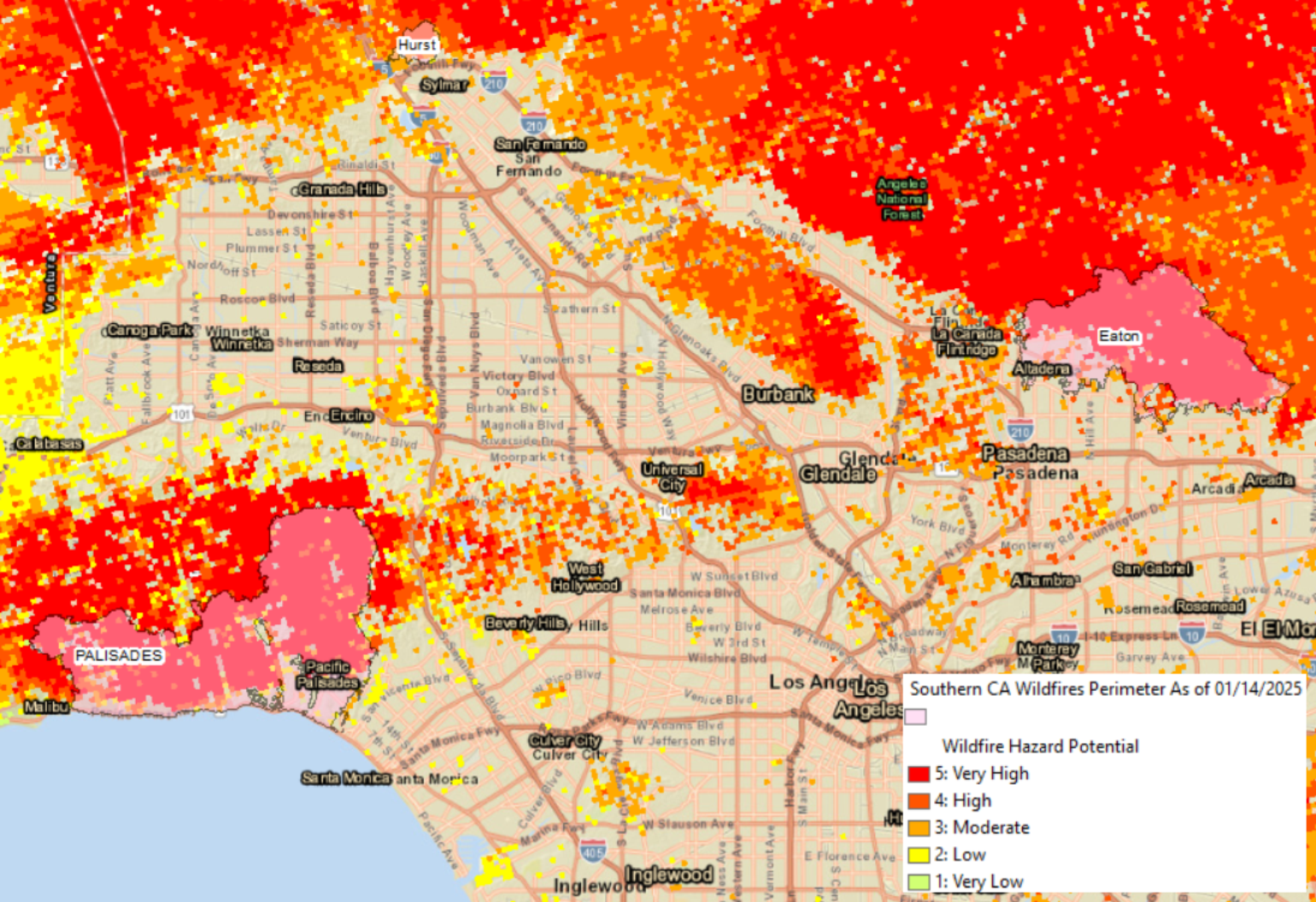
Lastly, according to FEMA's National Risk Index, Los Angeles County ranks at the top of US counties for fire risk, which shows just how risky wildfires are. Wildfires in the area should not be a surprise.
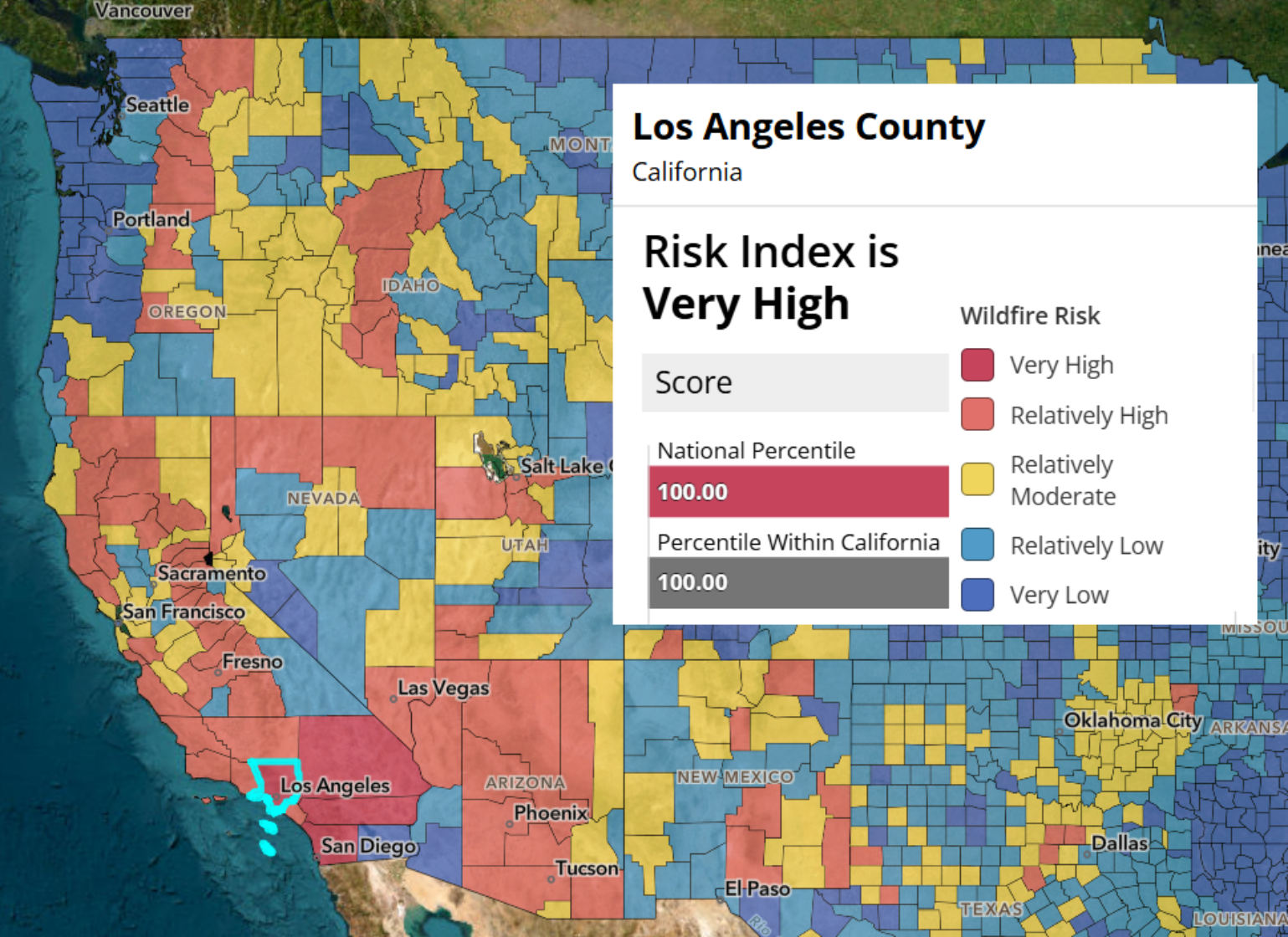
Thoughts on Current Industry Loss
By now, several loss estimates are being shared in the insurance media, but how easy is the estimate? Can we do some easy calculations? Sure, one can look at Zillow prices, but remember, land values are part of that Zillow price. You need to look at replacement cost of the building not land value. Authorities estimate that over 12,300 structures have been damaged or destroyed by the wildfires in the Greater Los Angeles area. The Eaton Fire is estimated to have damaged or destroyed over 7,000 structures, and the Palisades Fire around 5,000 structures. Damage assessments are ongoing. It has been reported that the estimated average residential replacement values in the Eaton area are about $1 million and exceed $2 million in both the Malibu and Pacific Palisades areas. So, a quick estimate yields $17B in insurance losses to be the floor, but we know the insurance losses here will not be formed from this simple calculation. These losses will likely exceed $25B as several factors will start to come into play that lead to the question of just how high that loss might be. Some of the questions that need to be asked that could drastically increase the losses center on how much will be paid out in additional living expenses. Hyper-demand surges in labor and materials will no doubt be a significant factor in an already expensive area of the country. We know disasters like these will take years, if not decades, to recover, and there are questions about how quickly this will occur with permitting. Still, clearly, the upcoming FIFA World Cup 2026 and Olympics 2028 could also strain resources as resources for skilled workers are limited. Many of the homes are bespoke and high-value, so it will take extra effort to understand designs and replacement costs. What factors will new laws and ordinances for either earthquake or wildfire might increase the rebuilding efforts of some structures? There are no doubt questions about possible fine art losses that might be more common in wealthy areas that have been affected. Smoke damage to structures outside the wildfire perimeter could add to the losses. Adjusters will be at a premium, and what type of litigation from claims disputes might arise, which could increase the loss-adjusted expense. Commercial losses can be more complex to estimate, and the resultant business interruption will add to the losses.
Some questions might question lower losses. How many structures are paid off and self-insured, and given that the CA Fair Plan only pays a maximum of $3M on residential policies, how much loss is covered above this? Are these structures self-insured above this limit, which would only widen the protection gap? How many structures were undervalued, given the high rate of replacement cost? The CA Fair Plan seems to be capped at $20M per location with new reforms offering a high-value commercial coverage option at $20M per building with $100M cap by per location, but how many of these policies have been issued since the reforms went in place in July 2024?
The event is still ongoing, and the fires are far from contained, with higher winds forecasted over the next couple of days. For this reason, and the reasons mentioned above, it is too early to provide any credible loss estimate. Still, this will likely be the largest wildfire loss in modern times, surpassing the Paradise, CA Campfire of 2018, which would be a $11.1B wildfire event loss if it occurred today. It should also be noted that this far exceeds Verisk's global average annual wildfire loss, which is 6% of the estimated $151B, which is about $9B annually.
To help with damage estimate LA County has launched a site where people and carriers can look up addresses in the Eaton & Palisades evacuation zones to see if they've been damaged, destroyed or are untouched by the fires.
Red = destroyed; Black = untouched; Yellow Green & Orange = damaged. In some areas, it's all red.
https://recovery.lacounty.gov/
Forecast For More Wind Events With Little Rain
A long-duration moderate Santa Ana wind event will continue through Wednesday. The winds were nowhere near as destructive as last week's, but the overall landscape is arid, so the insurance industry needs to remain alert to existing fires and any new fires that start. The Auto Fire in Ventura County started last night, but its forward progress was quickly stopped. This speaks to all the possible fire-fighting resources now on hand to handle the “fire of the day” if one were to start.
The long-range forecast shows that Santa Ana winds will pulse off and on over the next 10 days, with very little rain in sight. However, with an expected weather pattern change over North America at the end of the month that could bring rain to the area around January 26th - 29th.
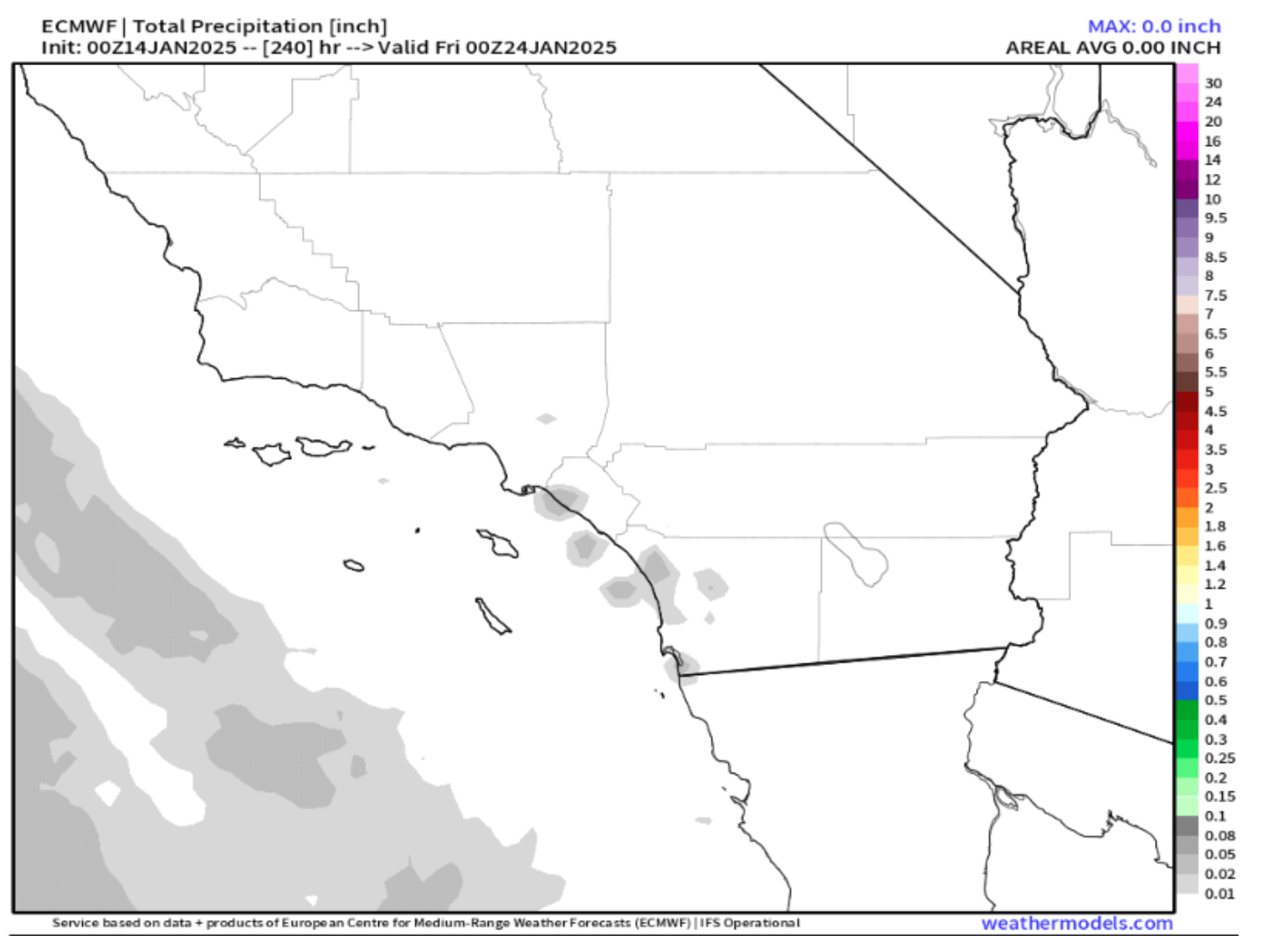
More updates will follow. BMS is here to support our clients with real-time wildfire analysis and forecasts during what appears to be a heightened extended period of wildfires across southern California until a more significant weather pattern changes.
